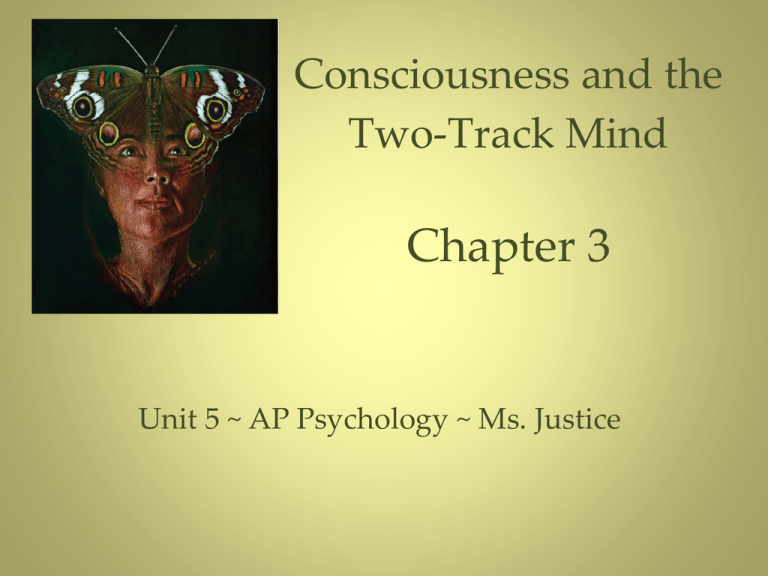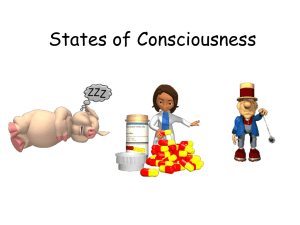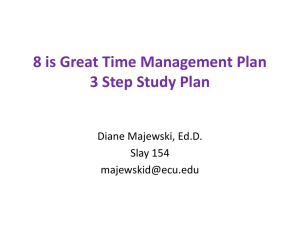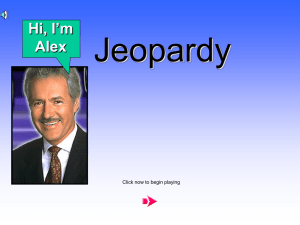
Consciousness and the
Two-Track Mind
Chapter 3
Unit 5 ~ AP Psychology ~ Ms. Justice
BIG IDEAS
The Brain & Consciousness
•Cognitive Neuroscience
•Dual Processing
Sleep & Dreams
•Biological Rhythms & Sleep
•Why Do We Sleep?
•Sleep Disorders
•Dreams
Hypnosis
•Facts & Falsehoods
•Explaining the Hypnotized State
Drugs & Consciousness
•Dependence & Addiction
•Psychoactive Drugs
•Influences on Drug Use
Near-Death Experiences
Forms of Consciousness
Consciousness, modern psychologists believe, is
an awareness of ourselves and our environment.
Fig. 3.1,
page 86
1: What is the “dual processing”
being revealed by today’s
cognitive neuroscience?
• Cognitive neuroscience is
the interdisciplinary study
of brain activity linked
with our mental processes
(what do brain scans of vegetative
patients asked to imagine playing
tennis reveal?)
• Recent research has revealed much of our brain
work occurs unconsciously, at the same time as
conscious processing. This is known as dual
processing.
The Hollow Face Illusion
• While you will mistakenly perceive the inside of a
mask as a protruding face, you will unhesitatingly
and accurately reach into the inverted mask to flick
off a bug-like object stuck to the mask.
• What your conscious mind doesn’t know, your
hand does!
Dragon Illusion
2: How much information do we
consciously attend to at once?
Selective Attention
Our conscious awareness
processes only a small part
of all that we experience.
We intuitively make use of the information
we are not consciously aware of.
The focusing of conscious awareness on a
particular stimulus is selective attention.
Inattentional Blindness
Inattentional blindness refers to the inability to
see visible objects (or people) when our
attention is directed elsewhere.
Simons & Chabris
(1999) showed that half
of the observers failed
to see the gorilla-suited
assistant in a ball
passing game.
Change Blindness
Change blindness is a form of inattentional
blindness in which two-thirds of individuals
giving directions failed to notice a change in the
individual asking for directions.
© 1998 Psychonomic Society Inc. Image provided courtesy of Daniel J. Simmons.
Change Blindness
3: How do our biological
rhythms influence our daily
functioning and our sleep
and dreams?
Sleep & Dreams
Sleep – we all do it!
Even when you’re asleep your perceptual window is not shut.
And, just as when we are awake, most information is
processed outside our conscious awareness.
Biological Rhythms and Sleep
Circadian Rhythms occur on a 24-hour cycle and include
sleep and wakefulness. Termed our “biological clock,” it
can be altered by artificial light.
Light triggers the suprachiasmatic nucleus (SCN) in the
hypothalamus to decrease the hormone melatonin.
Nightfall triggers an increase of melatonin.
4: What is the biological rhythm
of our sleep?
Sleep Stages
Measuring sleep: About every 90 minutes, we
pass through a cycle of five distinct sleep stages.
Sleep researchers
measure brainwave activity, eye
movements, and
muscle tension
by electrodes that
pick up signals
from the brain,
eye, and facial
muscles.
Hank Morgan/ Rainbow
Awake but Relaxed
When an individual closes his eyes but remains
awake, his brain activity slows down to a large
amplitude and slow, regular alpha waves.
A meditating person exhibits an alpha brain activity.
Sleep Stages 1-2
During early, light sleep (stages 1-2) the brain enters
a high-amplitude, slow, regular wave form called
theta waves.
A person who is daydreaming shows theta activity.
Stage 1: brief; may
experience images
resembling
hallucinations
Theta Waves
Stage 2: 20 minutes;
characterized by
sleep spindles
(bursts of rapid,
rhythmic brain-wave
activity)
Sleep Stages 3-4
During deepest sleep (stages 3-4), brain activity
slows down. There are large-amplitude, slow
delta waves.
Stage 3: transitional
Stage 4: deep sleep;
difficult to awaken;
children may wet the
bed or begin
sleepwalking
Stage 5: REM Sleep
After reaching the deepest sleep stage, the sleep cycle
starts moving backward from Stage 4, through Stage 3
and Stage 2. Then you enter REM sleep.
Although still asleep, the brain engages in lowamplitude, fast and regular beta waves much like
awake-aroused state.
The rapid eye movements of REM sleep signal the
beginning of a dream.
90-Minute Cycles During Sleep
With each 90-minute cycle, stage 4 sleep decreases
and the duration of REM sleep increases.
Why do we sleep?
We spend one-third of our
lives sleeping.
Jose Luis Pelaez, Inc./ Corbis
If an individual remains
awake for several days,
immune function and
concentration deteriorates
and the risk of accidents
increases.
5: How does sleep loss affect us?
Sleep Deprivation
1. Fatigue
2. Impaired concentration
3. Emotional irritability
4. Depressed immune system
5. Greater vulnerability
Accidents
Frequency of accidents increase with loss of sleep
6: What is sleep’s function?
Sleep Theories
1. Sleep Protects: Sleeping in the
darkness when predators loomed
about kept our ancestors out of
harm’s way.
2. Sleep Helps us Recover: Sleep helps restore and
repair brain tissue.
3. Sleep Helps us Remember: Sleep restores and
rebuilds our fading memories.
4. Sleep may play a role in the growth process:
During sleep, the pituitary gland releases growth
hormone. Older people release less of this
hormone and sleep less.
7: What are the major
sleep disorders?
Sleep Disorders
1. Insomnia: A persistent inability to
fall asleep.
2. Narcolepsy: Overpowering urge to
fall asleep that may occur while
talking or standing up.
3. Sleep apnea: Failure to breathe
when asleep.
Living With Cataplexy and Narcolepsy
Skeeter, the Narcoleptic Poodle
Sleep Disorders
Children are most prone to:
Night terrors: The sudden arousal from sleep
with intense fear accompanied by
physiological reactions (e.g., rapid heart rate,
perspiration) which occur during Stage 4
sleep.
Sleepwalking: A Stage 4 disorder which is
usually harmless and unrecalled the next
day.
Sleeptalking: A condition that runs in
families, like sleepwalking.
8: What do we dream?
Dreams
The link between REM
sleep and dreaming has
opened up a new era of
dream research.
What We Dream
Manifest Content: A Freudian term meaning
the story line of dreams.
1. Negative Emotional Content: 8 out
of 10 dreams have negative
emotional content.
2. Failure Dreams: People commonly dream about
failure, being attacked, pursued, rejected, or
struck with misfortune.
3. Sexual Dreams: Contrary to our thinking, sexual
dreams are sparse. Sexual dreams in men are 1 in
10; and in women 1 in 30.
9: What is the function of
dreams?
Why We Dream
1. Wish Fulfillment: Sigmund Freud suggested
that dreams provide a psychic safety valve to
discharge unacceptable feelings. The dream’s
manifest (apparent) content may also have
symbolic meanings (latent content) that signify
our unacceptable feelings.
2. Information Processing: Dreams may help sift,
sort, and fix a day’s experiences in
our memories.
Why We Dream
3. Physiological Function: Dreams provide the
sleeping brain with periodic stimulation to
develop and preserve neural pathways.
Neural networks
of newborns are
quickly
developing;
therefore, they
need more sleep.
Figure 3.14, p. 106
Why We Dream
4. Activation-Synthesis Theory: Suggests that the
brain engages in a lot of random neural
activity. Dreams make sense of this activity.
5. Cognitive Development: Some researchers
argue that we dream as a part of brain
maturation and cognitive development.
All dream researchers believe we need REM sleep.
When deprived of REM sleep and then allowed to sleep,
we show increased REM sleep called REM Rebound.
10: What is hypnosis, and what
powers does a hypnotist have
over a hypnotized subject?
Hypnosis
A social interaction in
which one person (the
hypnotist) suggests to
another (the subject)
that certain
perceptions, feelings,
thoughts, or behaviors
will spontaneously
occur.
Hypnos: Greek god of sleep
Facts and Falsehood
Those who practice hypnosis agree
that its power resides in the subject’s
openness to suggestion.
Can anyone experience hypnosis?
Yes, to some extent.
Can hypnosis enhance recall of
forgotten events?
No.
Facts and Falsehood
Can hypnosis force people to act
against their will?
No.
Can hypnosis be therapeutic?
Yes. Self-suggestion
can heal too.
Can hypnosis alleviate pain?
Yes. Lamaze can
do that too.
•Hypnosis seems especially helpful for treatment of obesity,
but drug, alcohol, and smoking addictions have not
responded well to hypnosis.
•In controlled studies, hypnosis produced the same results
as positive suggestions given without hypnosis.
11: Is hypnosis an extension of
normal consciousness or an
altered state?
Explaining the Hypnotized State
Courtesy of News and Publications Service, Stanford University
1. Social Influence Theory:
Hypnotic subjects may
simply be imaginative
actors playing a social
role.
2. Divided Consciousness
Theory: Hypnosis is a
special state of
dissociated (divided)
consciousness (Hilgard,
1986, 1992).
(Hilgard, 1992)
Mimi Forsyth
Both Theories
12: What are tolerance,
dependence, and addiction,
and what are some common
misconceptions about addiction?
Drugs and Consciousness
Psychoactive Drug: A chemical
substance that alters
perceptions and mood (affects
consciousness).
Psychoactive drugs are divided
into three groups:
1. Depressants
2. Stimulants
3. Hallucinogens
Dependence & Addiction
Continued use of a
psychoactive drug
produces tolerance.
With repeated
exposure to a drug,
the drug’s effect
lessens. Thus it takes
greater quantities to
get the desired effect.
Withdrawal & Dependence
Withdrawal: Upon stopping use of a drug (after
addiction), users may experience the undesirable
effects of withdrawal.
Dependence: Absence of a drug may lead to a
feeling of physical pain, intense cravings (physical
dependence), and negative emotions
(psychological dependence).
Misconceptions About Addiction
Addiction is a craving for a chemical substance,
despite its adverse consequences (physical &
psychological).
1. Addictive drugs quickly corrupt.
2. Addiction cannot be overcome voluntarily.
3. Addiction is no different than
repetitive pleasure-seeking
behaviors.
13: What are depressants,
and what are their effects?
Depressants
Depressants are drugs that reduce neural activity
and slow body functions. They include:
1. Alcohol
2. Barbiturates
3. Opiates
Depressants
1. Alcohol affects motor skills, judgment, and
memory…and increases aggressiveness while
reducing self awareness.
Ray Ng/ Time & Life Pictures/ Getty Images
Daniel Hommer, NIAAA, NIH, HHS
Excessive alcohol consumption can shrink
the brain, especially in women.
Drinking and driving can
produce disastrous results.
Depressants
2.
Barbiturates: Drugs that depress the activity of
the central nervous system, reducing anxiety
but impairing memory and judgment.
Nembutal, Seconal, and Amytal are some
examples.
Depressants
http://opioids.com/timeline
3. Opiates: Opium and its
derivatives (morphine and
heroin) depress neural activity,
temporarily lessening pain and
anxiety. They are highly
addictive.
When repeatedly flooded with
an artificial opiate, the brain
eventually stops producing its
own opiates, endorphins,
which can lead to overdose to
relieve pain.
14: What are stimulants,
and what are their effects?
Stimulants
Stimulants are drugs that excite neural activity and
speed up body functions. Examples of stimulants
are:
1.
2.
3.
4.
5.
6.
Caffeine
Nicotine
Cocaine
Ecstasy
Amphetamines
Methamphetamines
Caffeine & Nicotine
Caffeine and nicotine increase heart and
breathing rates and other autonomic functions to
provide energy.
http://office.microsoft.com/clipart
http://www.tech-res-intl.com
Why Do People Smoke?
1. People smoke because it is socially rewarding.
2. Smoking is also a result of genetic factors.
Russel Einhorn/ The Gamma Liason Network
Why Do People Smoke?
3.
Nicotine takes away
unpleasant cravings
(negative
reinforcement) by
triggering
epinephrine,
norepinephrine,
dopamine, and
endorphins.
4. Nicotine itself is
rewarding (positive
reinforcement).
Cocaine
Cocaine induces immediate euphoria followed by a crash.
Crack, a form of cocaine, can be smoked. Other forms of
cocaine can be sniffed or injected.
http://www.ohsinc.com
Ecstasy
Ecstasy or
Methylenedioxymethamphet
amine (MDMA) is a
stimulant and mild
hallucinogen. It produces a
euphoric high and can
damage serotonin-producing
neurons, which results in a
permanent deflation of mood
and impairment of memory.
15: What are hallucinogens,
and what are their effects?
Hallucinogens
Ronald K. Siegel
Hallucinogens are
psychedelic (mindmanifesting) drugs that
distort perceptions and
evoke sensory images in
the absence of sensory
input.
Hallucinogens
Hemp Plant
http://static.howstuffworks.com
1. LSD: (lysergic acid diethylamide) powerful
hallucinogenic drug that is also known as
acid.
2. THC (delta-9-tetrahydrocannabinol): is the
major active ingredient in marijuana (hemp
plant) that triggers a variety of effects,
including mild hallucinations.
Drugs
Summary
Table 3.3, page 123
16: Why do some people become
regular users of consciousnessaltering drugs?
Influences on Drug Use
The graph below shows the percentage of US highschool seniors reporting their use of alcohol, marijuana,
and cocaine from the 1970s to the late 1990s.
Figure 3.22, p. 124
Influences on Drug Use
The use of drugs is based on biological,
psychological, and social-cultural influences.
Figure 3.23, page 125
Marijuana Use
The use of marijuana in teenagers is directly related
to the “perceived risk” involved with the drug.
Influence for Drug Prevention and
Treatment
1. Education about the long-term costs
2. Efforts to boost people’s self-esteem and
purpose
3. Attempts to modify peer associations and
teaching refusal skills
17: What are near-death
experiences, and what is the
controversy over their
explanation?
Near-Death Experiences
(From “Hallucinations” by R.K. Siegel. Copyright
© 1977 Scientific American, Inc. All rights reserved.)
After a close brush with
death, many people
report an experience of
moving through a dark
tunnel with a light at the
end. Under the influence
of hallucinogens, others
report bright lights at
the center of their field
of vision.








